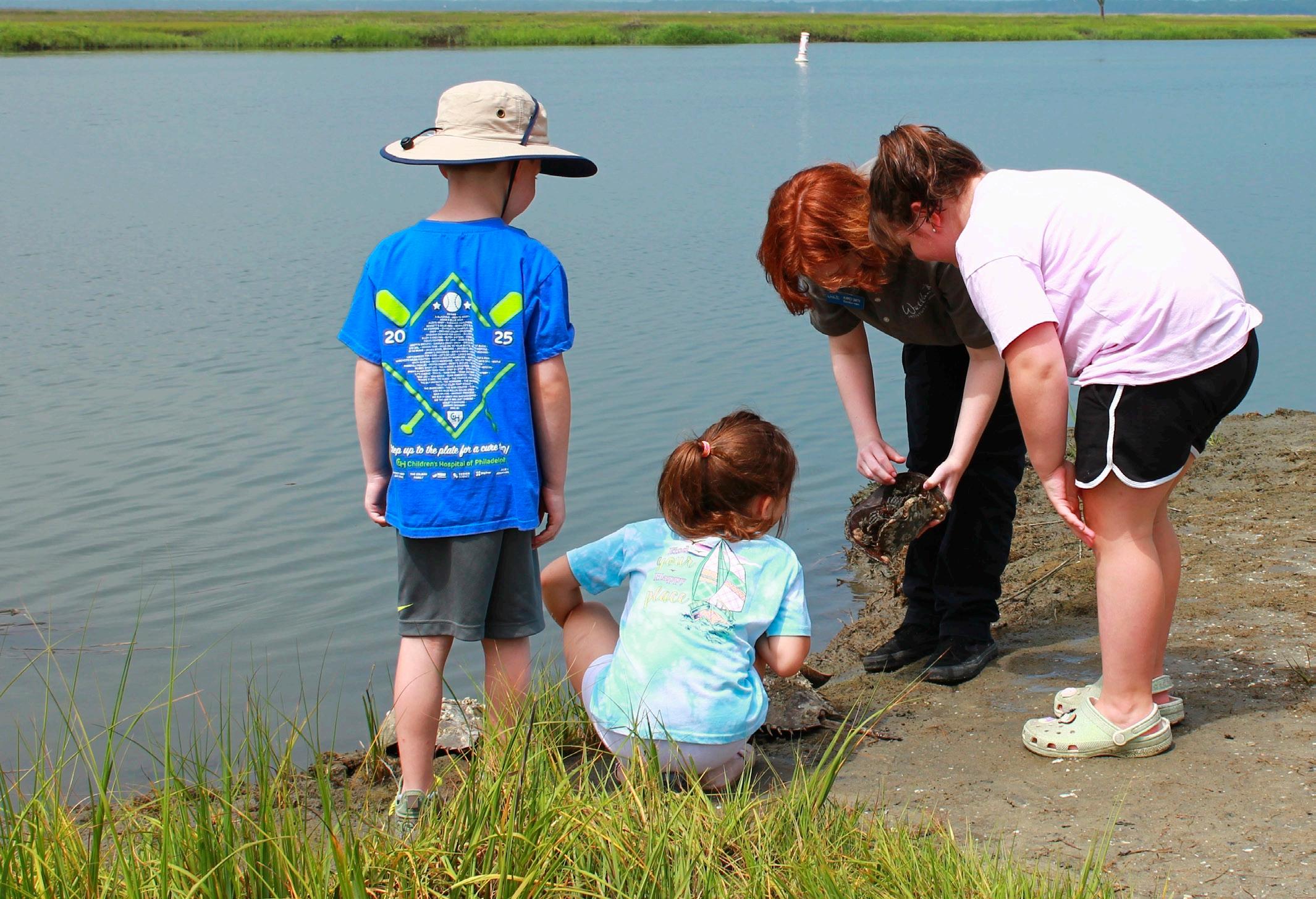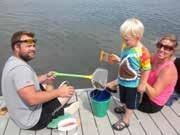The Collective Spirit of Environmental Education Sparking Interest a


What inspired you to teach environmental education? The answer to this question is as varied as the people answering it.
For me, the answer is simple. I teach environmental education for a chance to observe the spark – the spark you see on a person’s face when you know they have made a genuine connection to their environment. The perplexing thing about the spark is that you never know what is going to ignite it. Discovering the spark in your audience is the fundamental challenge of environmental education and the one I nd to be the most rewarding.
In pursuit of the spark, I began as a naturalist at the Dunes Learning Center, located within the Indiana Dunes National Lakeshore (now Indiana Dunes National Park), in Chesterton, Ind. At the Dunes Learning Center, I taught students from the greater Chicagoland area marine, wetland, forest, and prairie ecology amid some of the highest biodiversity in the country. In time, I moved on and found myself in the small town of Oregon, Ill., working at Northern Illinois University’s Lorado Taft Field Campus as an education program specialist. I spent my days coordinating outdoor experiences tailored to individual schools’ needs, teaching typical outdoor education activities, and watching bald eagles nest along the Rock River. Challenging myself in a new way, I spent several years working at the Indiana University, Purdue University Indianapolis Center for Earth and Environmental Science, where I developed and delivered an inquiry-based environmental science education program called “Discovering the Science of the Environment.” This program utilized place-based learning to assist in developing the next generation of environmentally literate citizens by
By Brooke Knapick of The Wetlands Institute
combining school ground natural areas, digital handheld data collection and data recording devices, a 20foot mobile technology trailer, and real student-led scienti c investigations. With my truck and trailer skills rmly mastered, life brought me here to The Wetlands Institute, where for nearly 13 years I have had the honor and privilege of stewarding a vision and re ning a structure that ignites the spark in the children and adults who visit The Wetlands Institute.
The Wetlands Institute o ers one of the best outdoor classroom environments in South Jersey, providing enriching and unique learning opportunities to students and the local community. Each year, upwards of 16,500 children and young adults from more than 170 local schools and organizations participate in our formal and nonformal education programs including environmental education eld trips, Science Education at Sea programs, traveling environmental education programs, group outreach programs, scout programs, and Nature Education for Homeschool Students and Teachers programs. With each program, we reach into classrooms and homes in New Jersey, New York, Pennsylvania, and Delaware, sharing the wonders of marine life with the local community, and enriching science curriculum for both students and teachers by providing wetland and boat-based opportunities for learning.
All our environmental education eld trip programs emphasize hands-on learning and the scienti c method. We believe children learn more from getting a little wet or muddy than from listening to a lecture. School groups visiting The Wetlands Institute range in age from kindergarten to high school and experience a variety of educational activities including:
• Exploring the unique ecosystem of the salt marsh.
• Learning about the food web connections among plants and animals.
• Examining the life and conservation e orts of the diamondback terrapin.
• Visiting the beach to observe and examine the plants and animals that call it home.
• Discovering the characteristics of a wetland by performing experiments including back-bay seining and soil testing.
With our newly launched undergraduate environmental education eld trip program, we are expanding these hands-on, feet-wet experiences to college-aged students majoring in biology, environmental science, wildlife conservation, ecology, and other related majors. This gives them the opportunity to take a deep dive into salt marsh and beach dynamics, terrapin conservation, biodiversity assessment, and the biological function and ecological importance of a variety of creatures that inhabit the waters of New Jersey’s back bays and coasts including horseshoe crabs, mollusk, plankton, and beach invertebrates. These eld trips are completely customizable, and each learning activity is designed to complement the coursework being done in the classroom. By the end of this immersive eld experience, students are left with a deeper understanding of wetlands and/ or barrier beach ecology and the many interconnected components that make up these complex ecosystems. While a visit to The Wetlands Institute is sure to be a memorable experience, our traveling environmental education and group outreach programs bring all The Wetlands Institute o ers to schools, libraries, campgrounds, and local youth organizations across the tri-state area. For continued on page 58

more than 20 years, these exciting live animal presentations have reached beyond the borders of the marsh and allowed participants to use all their senses and imagination to discover the wet world of these watery animals. After several years of dedicated e ort, we are proud to now o er a full suite of adult outreach programs that feature more in-depth content tailored to an adult-only audience. These programs are wonderful opportunities for adult learners to engage at all stages of life and range in topic from Turtles of New Jersey, to Migration at the Shore, to Barrier Beach Ecology. And, of course, at the heart of it all, these programs still feature live animals


and the opportunity to touch and interact with them because we believe you are never too old to keep learning.
As we grow our in-person programs, our Virtual Wetlands Experience continues to inspire and foster a virtual connection to the natural world, increasing accessibility and reaching new audiences and visitors around the globe. Since launching in 2020, we have added 75% new content across all areas including Salt Marsh Safari, Terrapin Tales, and Aquarium Bytes virtual visits as well as our kids activity packets and educator resources, drawing in more than 15,350 visits to the website during that time. These interactive spaces include dynamic and stat-

ic content created by full-time education department sta as well as environmental education interns, making it a unique and one-of-a-kind platform. As the Virtual Wetlands Experience evolves, it re ects the individual spirit and passion of each contributor and o ers a diverse array of activities and resources for everyone at their level of engagement.
This year, we were fortunate to build upon the past success of our long-standing programs and invite new audiences to engage with our programs in a meaningful way. Much has changed within the realm of education since the rst visitors, students, and teachers set






foot upon the marsh more than 50 years ago. But by the same token, much remains the same. What remains the same is a desire to teach environmental education, to allow individuals to create a genuine connection to their environment. Whether it be o ering our grounds as an immersive outdoor learning space, partnering with local schools to provide place-based education programs on their school grounds, or by continuing to o er our traditional in-person programs, alongside our interactive virtual program options, we welcome visitors and participants of all ages to choose from a number of hands-on activities and/or virtual experiences to customize a wetlands experience in the best format for each family group, classroom, youth group, campground, or organization.
The success the education department is experiencing today is not my suc-
cess alone – it is the collective success of every education leader and sta member before me who provided their unique vision, thoughtful insight, sel ess mentorship, personal sacri ce, and passionate dedication for the advancement of environmental education. Lessons from the past shape decisions for the future. As educators, we learn from the past and journey forward to educate, mentor and inspire the next generation of scientists, educators, and environmental stewards.
As we journey together toward the future, we remind ourselves we teach environmental education for the chance to observe the spark. We know we have done our job when we actually observe the spark. I hope you will join us in celebrating the nearly 55 years of education here at The Wetlands Institute and consider investing in the future of educational achievements yet to come.





